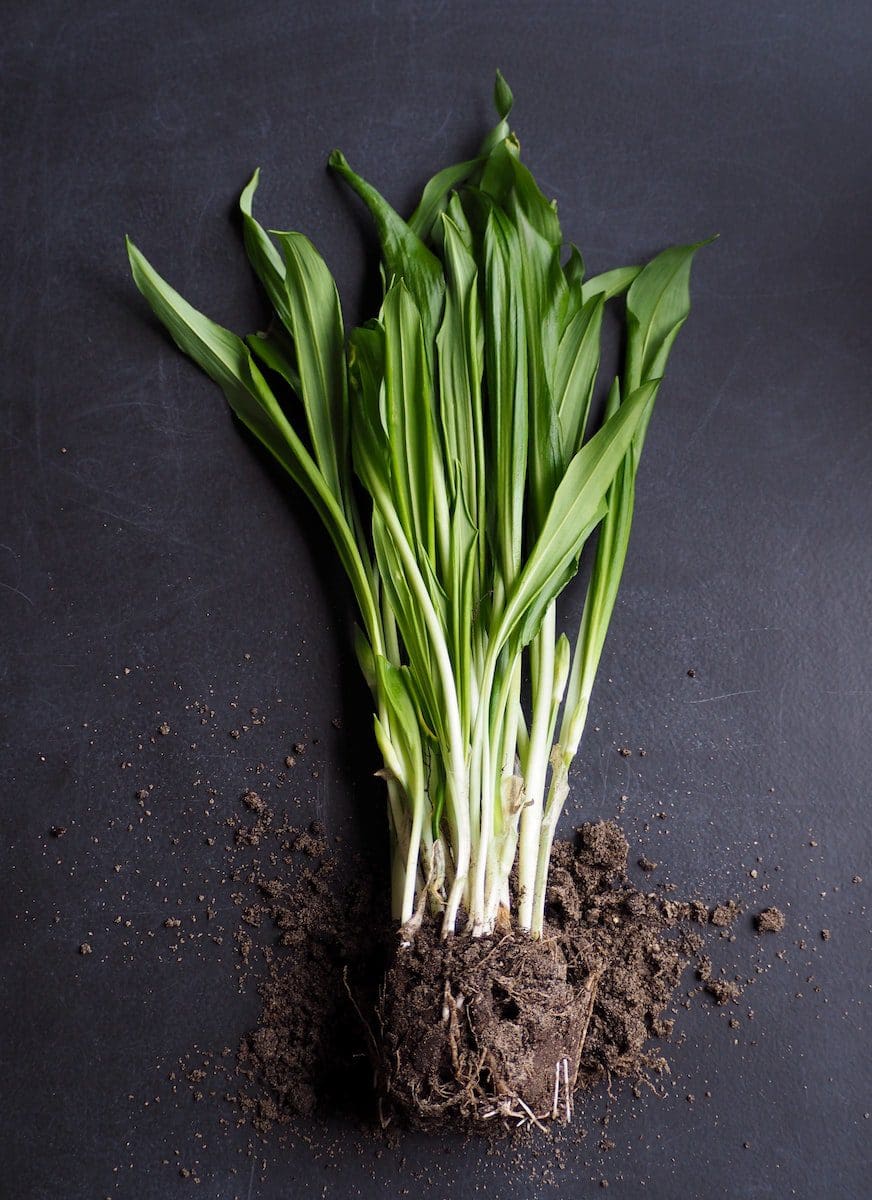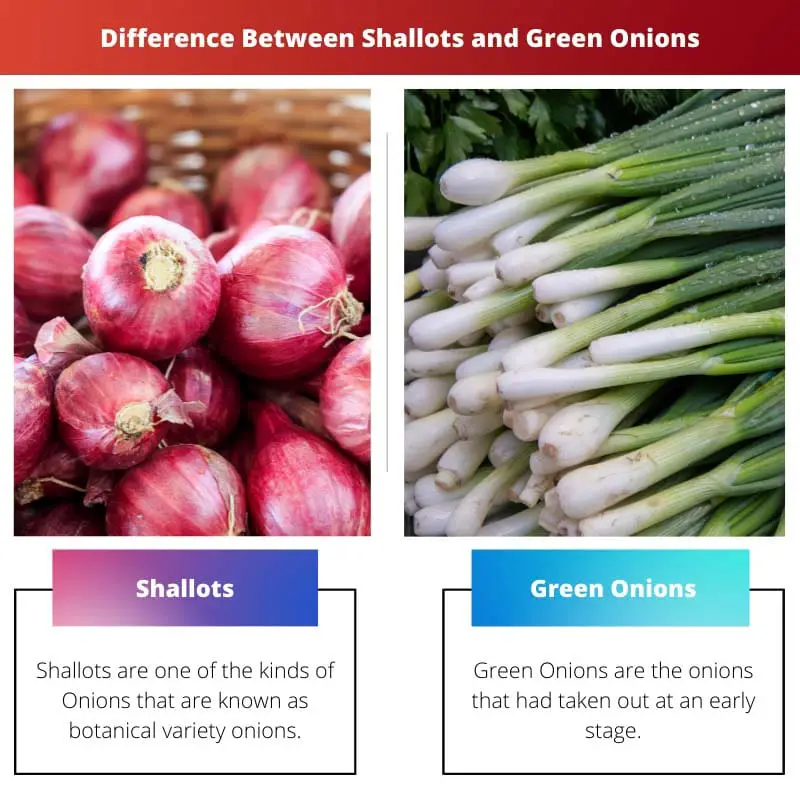We have types of ingredients that add taste to our dishes. Onions had used as the ingredients that add flavour to the dish. Onions are health products that help to give immunity to our bodies.
Onions are available in various kinds. Shallots and Green Onions are the types of onions used by the population.
Key Takeaways
- Shallots are a type of onion with a milder flavor and a more elongated shape than regular onions.
- Green onions, also known as scallions, are a type of onion that has yet to develop a bulb.
- Shallots have a sweeter taste and are commonly used in French cuisine, while green onions have a milder taste and are commonly used in Asian cuisine.
Shallots vs Green Onions
The difference between Shallots and Green Onions is that Shallots are one of the types of onion species where it had separated and classified as Allium Cepa. In Contrast, Green Onions are the onions that had been taken out before fully grown. The taste and sharpness vary from each other.

Shallots are one of the kinds of onions that are known as botanical variety onions. An individual can grow these Shallots in USDA Hardness 2-10 conditions.
Usually, the seeds of the shallots will cultivate in the spring season, which helps to get good results in cultivation. Later in 2010, the crop of the Shallots had separated from the onions family and was classified as Allium Cepa.
Shallots had used scrap raw and cooked by adding various salads.
Green Onions are one of the kinds of onions which had known as immature onions. The Green Onions had been taken out before the whole cultivation means they had been taken out at the early baby stage.
The structure of the Green Onions looks like roots where the top part is in green colour, and the bottom is in white. Green Onions had different names, like Scallions and Spring Onions.
Comparison Table
| Parameters of Comparison | Shallots | Green Onions |
|---|---|---|
| Meanings | Shallots are one of the kinds of Onions that are known as botanical variety onions. | Green Onions are the onions that had taken out at an early stage. |
| Family | Shallots are obtaining from the Allium family. | Green Onions had obtained from the Allium Fistulosum Family. |
| Other labels | The other label of the Shallots is Cepa and, it had a close relation with leeks, chives and some others. | Green Onions have the other labels as Salad Onions, Spring Onions and Scallions. |
| Production | Shallots cultivate by the seeding process and, sometimes the early forming bulbs had used to fertilize the Shallots. | Although the crop will take out before the bulb stage, Green Onions are examining as bulb varieties. |
| Season | Shallots had cultivated in the pre-mature spring season, where the crop comes out at the beginning of the summer season. | Green Onions will cultivate in April or sometimes in May. These onions had been handled to grow in the garden area. |
What are Shallots?
People like to eat dishes with the ingredient like onions. Shallots use to prepare the dish items with taste. Shallots are one of the kinds of Onions that had cultivated throughout the world.
These Shallots had known as botanical variety onions up to 2010. The Shallots had separated and Classified as Allium Cepa. Shallots had been considered a member of the Allium family.
Shallots grow in the starting stage of the spring season, and these had cultivated by seeding.
Sometimes shallots will use to fertilize the early-forming bulbs. An individual can nurture the Shallots crop from early forming bulbs. The Shallots crop can grow under USDA Hardness 2-10 conditions.
Although it is a type of onion, later in 2010, the Crop of the Shallots separated from the onions family and was classified as Allium Cepa. Shallots will grow in the period of 60 to 120 days.
To get the required size of shallots, an individual should cultivate the related size of bulbs on the first day.
The other label of the Shallots is Cepa, and it had a close relation with leeks, chives and some others. Shallots will cultivate at the beginning of the spring season when the crop comes out early in the summer season.
Shallots will grow in the mountain places in countries like Iran and Iraq, where these will grow widely starting from central to Southwest Asia.
Shallots from the Allium Cepa family had a cultivated group which had named as ‘Aggregatum group’. These Shallots are matured and classified into cloves. 75 calories had contributed by each shallot.
The Shallots comprise nutrients like proteins, Fiber, Calcium, Carbs, Magnesium and Calcium. Shallots are healthy food, and it gives daily value nutrients to our body.

What are Green Onions?
Green Onions are the kind of onions that helps in health improvement. Green Onions had produced by taking the Onions at the early stage, that is, at the bulb stage. Green Onions were considered a member of the Allium Fistulosum Family.
Green Onions have other labels such as Salad Onions, Spring Onions and Scallions, and these had taken to cultivate in garden areas.
Green Onions can fertilize in any season rather than the rainy season because the rainy season does not suit the cultivation of the Green Onion crop.
Green Onions had taken out at the starting stage of the bulb, where these are popular to pronoun as immature onions. The structure of the Green Onions looks like roots where the top part is green colour, and the bottom is white.
Although the crop had taken out before the bulb stage, Green Onions are examined as bulb varieties. Green Onions crop had used to grow in garden places in April and May.
Green Onions form the bulbs rapidly, and the top of these Onions remain green in colour. Green Onions had used to cultivate for 20 to 30 days, and the outcomes are in immature form.
If an individual grows the crop up to 100 to 175 days, then the mature onions will be available.
The Green Onions will grow in conditions where the pH of the soil is up to 6 to 7.5 and the soil is drained in nature. Green Onions comprise 32 calories and gained calories help in our body growth.
To health, green onions contain the proteins like Calcium, Magnesium, and iron, 31% of Vitamin-C, and 5% of Vitamin-B6. It provides potassium, sugar and Dietary fibre on a daily value.

Main Differences Between Shallots and Green Onions
- Shallots are the matured onions, whereas Green Onions are the starting stage of Onions.
- Shallots can cultivate in the primary spring season, whereas Green Onions can fertilize in every well-behaved exclude in the rainy season.
- Shallots used to grow in mountains where Green Onions can cultivate in Garden places.
- An individual can gain 75 Calories from Shallots, whereas Green Onions can produce 32 Calories.
- The shallots can extract in 60 to 120 days, and the Green Onions had pulled in 20 to 30 days.

- https://www.sciencedirect.com/science/article/pii/B9781845690175500221
- https://pubs.acs.org/doi/abs/10.1021/bk-1992-0507.ch016

The article provides a thorough explanation of the difference between shallots and green onions, and the production process of each type. It’s informative to know about their nutrient composition and the calories each shallot provides.
The details about the nutritional content of shallots and the process of cultivation are quite intriguing. The article offers valuable insights into their plant taxonomy and usage in different cuisines.
The article’s comprehensive coverage of the botanical and agricultural aspects of shallots and green onions provides a valuable resource for culinary enthusiasts. It offers a deep understanding of these ingredients.
The article’s insights into the botanical classification and agricultural practices related to shallots and green onions contribute to an enriched understanding. It provides detailed knowledge about these ingredients.
Understanding the differences between shallots and green onions is essential for culinary enthusiasts. The article elaborates well on the variances in taste, classification, and types of dishes they are commonly used in.
The comparison table is particularly helpful in discerning the distinctions between shallots and green onions. It’s a comprehensive guide for individuals seeking in-depth knowledge about these ingredients.
The rich historical, geographical, and nutritional details about shallots and green onions greatly enhance the article’s informative value. It provides an insightful perspective for individuals seeking to learn about these ingredients.
The article’s educational depth in presenting the origins and usage of shallots and green onions is commendable. The informative content on their unique attributes is compelling for readers.
The detailed nutritional and geographical insights about shallots and green onions provide enriching information. The article offers comprehensive knowledge about these ingredients for culinary exploration.
The detailed descriptions of shallots and green onions contribute to a better understanding of their culinary applications. The historical and geographical dimensions add an enriching context to the information presented.
Culinary enthusiasts will appreciate the comprehensive details about shallots and green onions provided. The cultural and regional influences on these ingredients are intriguingly portrayed.
The article’s coverage of the ethnic usage of shallots and green onions enhances comprehension of their global culinary relevance. It is an informative piece for individuals exploring their cooking ingredients.
The article accurately presents the differences between shallots and green onions, providing valuable insights into their growth and usage in diverse cuisines. The nutritional contributions of these ingredients are well highlighted.
The article’s focus on the cultivation and classification of shallots and green onions brings depth to its informative portrayal. The botanical and seasonality details offer a holistic perspective.
The thorough elucidation of shallots and green onions encompasses their taxonomical positioning and attributes related to their seasonal growth. The comparisons contribute to a comprehensive understanding.
The article delivers detailed information about shallots and green onions, covering aspects such as their family, production, and seasonal growth. The historical context and use in various cuisines are described very well.
The botanical and agricultural details provided in the article are enlightening. It addresses the specific attributes of shallots and green onions, enhancing the understanding of their culinary relevance.
The geography of shallot cultivation and their categorization within the Allium family are fascinating topics. The article presents these subjects with scientific precision and clarity.
The detailed breakdown of shallots and green onions, along with their distinct characteristics, is paramount for individuals interested in exploring diverse ingredients. The seasonal and geographical aspects are particularly insightful.
The comprehensive details regarding the production and family classification of shallots and green onions are well-articulated. The article serves as an educational resource for readers seeking culinary knowledge.
The nutritional and agricultural information about shallots and green onions greatly enhances the understanding of these ingredients. The article serves as an instructive guide for individuals interested in diverse culinary elements.
The article offers an insight into the unique attributes of shallots and how they differ from green onions. The nutritional value and geographical distribution of shallots are noteworthy details worth noting.
The details about the caloric content of shallots and the various classifications based on geographical regions bring a deeper understanding of these ingredients. The article is rich in factual information.